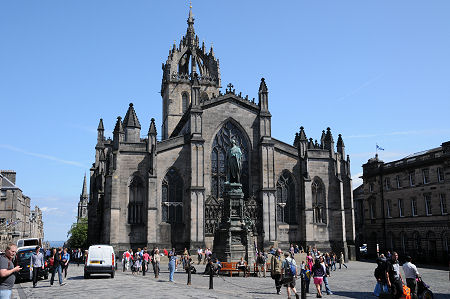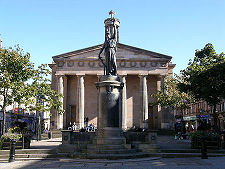 St Giles' Cathedral in Edinburgh |
Saint Giles lived from about 650 to about 710. He is also known as Giles the Hermit and is the patron saint of lepers and, amongst many other places across Europe, Edinburgh and Elgin. The wider picture in Scotland at the time is set out in our Historical Timeline.
Saint Giles was said to have been the son of King Theodore and Queen Pelagia of Athens, though doubt has been cast on the historical accuracy of this claim. Whatever his origins, he seems to have spent most of his life in the area around modern Arles and Nîmes in southern France. According to legend he became a hermit deep in the forests of the area, with his only companion being a deer. His solitude came to an end when hunters catching meat for the Frankish King Wamba chased the deer and accidentally shot St Giles with an arrow.
By way of recompense, King Wamba built a monastery for Giles, which became known as Saint-Gilles-du-Gard. Giles placed the monastery under the Benedictine rule and spent the remainder of his life there, gaining a reputation for piety and miracles that spread far and wide.
One persistent story is that during a mass conducted by Giles to pardon the Emperor Charlemagne's sins, an angel placed on the altar a letter detailing a sin that was so terrible that Charlemagne had never dared to confess it. The problem with the story from a historical point of view is that Charlemagne was not born until around three decades after Giles died. The best interpretation for the story is that it was a later invention, intended to harm Charlemagne's reputation. What is perhaps more significant is that those who invented the story chose to feature St Giles within it, thus making capital from a reputation that must already have been strong.
Saint Giles remains highly venerated today. The centre of his cult is the abbey at Saint-Gilles-du-Gard, which can still be found near Nîmes in southern France and remains a place of pilgrimage. During the middle ages a large number of churches across Europe were dedicated to St Giles, including St Giles' Cathedral in Edinburgh and St Giles' Church in Elgin. Meanwhile he is the patron saint of lepers, disabled people, the mentally ill, hermits, horses, outcasts, beggars, poor people, blacksmiths and spur makers, amongst many others. He is also the patron saint of Edinburgh, Elgin, Graz, Nuremberg, Osnabrück, Sankt Gilgen, Brunswick, Wollaberg, Saint-Gilles (near Brussels) and Saint-Gillis-Waas and his feast day is 1 September.

